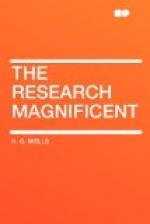Young people and unseasoned people, Benham argued, are apt to imagine that if fear is increased and carried to an extreme pitch it becomes unbearable, one will faint or die; given a weak heart, a weak artery or any such structural defect and that may well happen, but it is just as possible that as the stimulation increases one passes through a brief ecstasy of terror to a new sane world, exalted but as sane as normal existence. There is the calmness of despair. Benham had made some notes to enforce this view, of the observed calm behaviour of men already hopelessly lost, men on sinking ships, men going to execution, men already maimed and awaiting the final stroke, but for the most part these were merely references to books and periodicals. In exactly the same way, he argued, we exaggerate the range of pain as if it were limitless. We think if we are unthinking that it passes into agony and so beyond endurance to destruction. It probably does nothing of the kind. Benham compared pain to the death range of the electric current. At a certain voltage it thrills, at a greater it torments and convulses, at a still greater it kills. But at enormous voltages, as Tesla was the first to demonstrate, it does no injury. And following on this came memoranda on the recorded behaviour of martyrs, on the self-torture of Hindoo ascetics, of the defiance of Red Indian prisoners.
“These things,” Benham had written, “are much more horrible when one considers them from the point of view of an easy-chair";—White gave an assenting nod—“Are they really horrible at all? Is it possible that these charred and slashed and splintered persons, those Indians hanging from hooks, those walkers in the fiery furnace, have had glimpses through great windows that were worth the price they paid for them? Haven’t we allowed those checks and barriers that are so important a restraint upon childish enterprise, to creep up into and distress and distort adult life? . . .
“The modern world thinks too much as though painlessness and freedom from danger were ultimate ends. It is fear-haunted, it is troubled by the thoughts of pain and death, which it has never met except as well-guarded children meet these things, in exaggerated and untestable forms, in the menagerie or in nightmares. And so it thinks the discovery of anaesthetics the crowning triumph of civilization, and cosiness and innocent amusement, those ideals of the nursery, the whole purpose of mankind. . . .”




